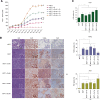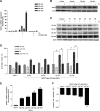Obesity associated alterations in the biology of adipose stem cells mediate enhanced tumorigenesis by estrogen dependent pathways
- PMID: 24176089
- PMCID: PMC3978929
- DOI: 10.1186/bcr3569
Obesity associated alterations in the biology of adipose stem cells mediate enhanced tumorigenesis by estrogen dependent pathways
Abstract
Introduction: Obesity has been associated with increased incidence and mortality of breast cancer. While the precise correlation between obesity and breast cancer remains to be determined, recent studies suggest that adipose tissue and adipose stem cells (ASCs) influence breast cancer tumorigenesis and tumor progression.
Methods: Breast cancer cells lines were co-cultured with ASCs (n = 24), categorized based on tissue site of origin and body mass index (BMI), and assessed for enhanced proliferation, alterations in gene expression profile with PCR arrays, and enhanced tumorigenesis in immunocompromised mice. The gene expression profile of ASCs was assess with PCR arrays and qRT-PCR and confirmed with Western blot analysis. Inhibitory studies were conducted by delivering estrogen antagonist ICI182,780, leptin neutralizing antibody, or aromatase inhibitor letrozole and assessing breast cancer cell proliferation. To assess the role of leptin in human breast cancers, Oncomine and Kaplan Meier plot analyses were conducted.
Results: ASCs derived from the abdominal subcutaneous adipose tissue of obese subjects (BMI > 30) enhanced breast cancer cell proliferation in vitro and tumorigenicity in vivo. These findings were correlated with changes in the gene expression profile of breast cancer cells after co-culturing with ASCs, particularly in estrogen receptor-alpha (ESR1) and progesterone receptor (PGR) expression. Analysis of the gene expression profile of the four groups of ASCs revealed obesity induced alterations in several key genes, including leptin (LEP). Blocking estrogen signaling with ICI182,780, leptin neutralizing antibody, or letrozole diminished the impact of ASCs derived from obese subjects. Women diagnosed with estrogen receptor/progesterone receptor positive (ER+/PR+) breast cancers that also expressed high levels of leptin had poorer prognosis than women with low leptin expression.
Conclusion: ASCs isolated from the abdomen of obese subjects demonstrated increased expression of leptin, through estrogen stimulation, which increased breast cancer cell proliferation. The results from this study demonstrate that abdominal obesity induces significant changes in the biological properties of ASCs and that these alterations enhance ER+/PR+ breast cancer tumorigenesis through estrogen dependent pathways.
Figures






Similar articles
-
Leptin produced by obese adipose stromal/stem cells enhances proliferation and metastasis of estrogen receptor positive breast cancers.Breast Cancer Res. 2015 Aug 19;17(1):112. doi: 10.1186/s13058-015-0622-z. Breast Cancer Res. 2015. PMID: 26286584 Free PMC article.
-
Obesity-Altered Adipose Stem Cells Promote Radiation Resistance of Estrogen Receptor Positive Breast Cancer through Paracrine Signaling.Int J Mol Sci. 2020 Apr 15;21(8):2722. doi: 10.3390/ijms21082722. Int J Mol Sci. 2020. PMID: 32326381 Free PMC article.
-
Leptin regulation of the p53-HIF1α/PKM2-aromatase axis in breast adipose stromal cells: a novel mechanism for the obesity-breast cancer link.Int J Obes (Lond). 2018 Apr;42(4):711-720. doi: 10.1038/ijo.2017.273. Epub 2017 Nov 6. Int J Obes (Lond). 2018. PMID: 29104286 Free PMC article.
-
Estrogen metabolites and breast cancer.Steroids. 2015 Jul;99(Pt A):61-6. doi: 10.1016/j.steroids.2014.08.003. Epub 2014 Aug 26. Steroids. 2015. PMID: 25168343 Review.
-
The effect of obesity on adipose-derived stromal cells and adipose tissue and their impact on cancer.Cancer Metastasis Rev. 2022 Sep;41(3):549-573. doi: 10.1007/s10555-022-10063-1. Epub 2022 Aug 24. Cancer Metastasis Rev. 2022. PMID: 35999486 Review.
Cited by
-
Obesity and leptin in breast cancer angiogenesis.Front Endocrinol (Lausanne). 2024 Oct 8;15:1465727. doi: 10.3389/fendo.2024.1465727. eCollection 2024. Front Endocrinol (Lausanne). 2024. PMID: 39439572 Free PMC article. Review.
-
Adipose Tissue-Derived Mesenchymal Stromal/Stem Cells, Obesity and the Tumor Microenvironment of Breast Cancer.Cancers (Basel). 2022 Aug 12;14(16):3908. doi: 10.3390/cancers14163908. Cancers (Basel). 2022. PMID: 36010901 Free PMC article. Review.
-
Leptin produced by obese adipose stromal/stem cells enhances proliferation and metastasis of estrogen receptor positive breast cancers.Breast Cancer Res. 2015 Aug 19;17(1):112. doi: 10.1186/s13058-015-0622-z. Breast Cancer Res. 2015. PMID: 26286584 Free PMC article.
-
Adipose-Derived Stem Cells in Novel Approaches to Breast Reconstruction: Their Suitability for Tissue Engineering and Oncological Safety.Breast Cancer (Auckl). 2017 Aug 16;11:1178223417726777. doi: 10.1177/1178223417726777. eCollection 2017. Breast Cancer (Auckl). 2017. PMID: 29104428 Free PMC article. Review.
-
Bisphenol A enhances adipogenic differentiation of human adipose stromal/stem cells.J Mol Endocrinol. 2014 Dec;53(3):345-53. doi: 10.1530/JME-14-0052. Epub 2014 Aug 20. J Mol Endocrinol. 2014. PMID: 25143472 Free PMC article.
References
MeSH terms
Substances
Grants and funding
LinkOut - more resources
Full Text Sources
Other Literature Sources
Medical
Research Materials
Miscellaneous

